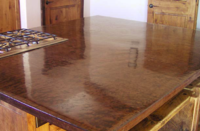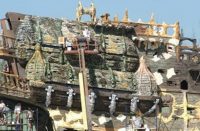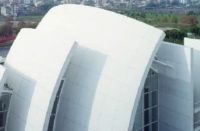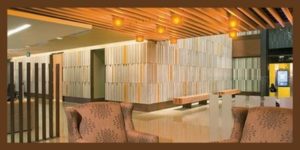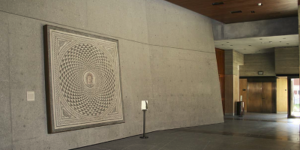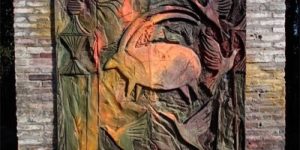Slip Stone
Architectural finishes have always been a factor in commercial and public work projects. As the industry has changed, owners and architects have sought out different techniques and finishes.
Michael Allen Sr. had been mulling an idea around for some time. The concrete goes in the front, the wall comes out the back. How to add a decorative finish to a vertical wall as it was extruded was the question. The answer came earlier this year, and already commercial projects are exhibiting the ingenious results.
Allen, owner and president of Allen & Sons Construction Inc. in French Camp, Calif., learned the concrete trade from his uncle and formed his own business in 1979. His new patent-pending invention, the Slip Stone Extruded Wall system, is the result of years of experience and recent concerns about staying competitive in the marketplace.
“Architectural finishes have always been a factor in commercial and public work projects. As the industry has changed over the past 20 years, owners and architects have sought out different techniques and finishes. However, developers aren’t always willing to pay for decorative concrete created with traditional methods,” Allen observes.
A New Concept
In May 2001, Allen began experimenting with his Slip Stone prototype. A textured mold wrapped around a roller that was attached to one of his Gomaco machines. One of the first challenges was finding the right texture and mold material to affix to the roller. Allen explains, “The key was finding a soft and forgiving material that would leave an imprint. Metal wanted to indent the concrete and pop the aggregate out. We found that our special soft rubber compound married well with the soft concrete”. Developing the right concrete design meant working closely with the ready mix company.
 Another challenge was combating the buildup of material on the roller. Allen says, “During the experimental phase for placing the walls, we had a buildup of cement material on the roller which required a lot more labor and release agent. We needed to find a better way. One day, we happened to look around our shop and came across some thin mill plastic. A plastic picnic table covering.”
Another challenge was combating the buildup of material on the roller. Allen says, “During the experimental phase for placing the walls, we had a buildup of cement material on the roller which required a lot more labor and release agent. We needed to find a better way. One day, we happened to look around our shop and came across some thin mill plastic. A plastic picnic table covering.”
Allen’s crew attached the roll of plastic to the Gomaco machine. As it unrolled over the freshly extruded concrete, the textured finish rolled right over it. He says the plastic sheeting cut labor needs by two-thirds, because they didn’t have to keep cleaning buildup off the decorative mold. “I was able to move those extra crew members to other jobs. Then, after an hour — more or less — we peeled the plastic off and the perfect finish was achieved. And we can cut deep joints and control joints right through the plastic.”
New Developments
In July 2001, two months after he began experimenting with the prototype, Allen & Sons produced a sample product for Grupe Co. and landed a $258,000 project at one of the development firm’s new lakefront communities. Interestingly, the walls that Allen’s Gomaco machine extruded for the Grupe project were too straight. The developer wanted an Old World wobbly look, “so we had to bump the machine a little bit every now and again to achieve the look. Grupe is very pleased [with the results] and has plans on the drawing board for another project in the next quarter,” Allen reports.
Contrary to what one might assume, the Slip Stone system does not slow down the pace of the extruding machine, Allen says. “Speed depends on height, width and the concrete volume you can get through the machine. Moving slowly and vibrating well is important to control slump. Even if we use rebar, we add fiber mesh to the mix to help bind everything together.” And the Slip Stone system can imprint all visible surfaces of the extruded wall — front, back and top — whatever is needed.
On some projects integrally colored concrete is beneficial. “It depends on the final results you want. If you want dark-colored or green stones, it’s better to use integrally colored concrete — three pounds of base color per yard of concrete. Liquid color works best. This gives the wall an initial darkening that you can apply stain colors o quickly.”
Acid Stains
Allen only uses acid stains on his Slip Stone projects. “You can get so many varieties of colors. We make a 5-foot to 10-foot sample wall to show colors for a client. If the client wants to see a mortar line, we brush a light coating of oil on the mortar lines to reduce the acid coloring on those areas.” Acid staining goes quickly, too. On the Grupe project, a two-man crew achieved the desired design color on 3,600 linear feet of wall (4 feet tall by 1-foot wide) in three days.
Four design patterns are currently available: random stone, stacked stone, slate and old barn board. An Old World brick design is on the drawing table. But, Allen says, whatever the client wants he can make. “We cast our own molds right off the natural material and build the roller to fit.” A traditional brick design with straight mortar lines is not recommended, however, because the concrete naturally wants to slump. That would result in sagging mortar lines.
 The Slip Stone system is adaptable to most slip-forming machines. The rollers are interchangeable and attach to an adjustable bracket that allows you to adjust the depth of the pattern. It takes 10 minutes to take one roller off and put another on, Allen reports. Stacking mold designs on a single roller offers additional possibilities — one could envision a highway sound barrier wall featuring a scene of waves breaking on a beach beneath a cloud-filled sky.
The Slip Stone system is adaptable to most slip-forming machines. The rollers are interchangeable and attach to an adjustable bracket that allows you to adjust the depth of the pattern. It takes 10 minutes to take one roller off and put another on, Allen reports. Stacking mold designs on a single roller offers additional possibilities — one could envision a highway sound barrier wall featuring a scene of waves breaking on a beach beneath a cloud-filled sky.
Uses for Slip Stone
For subdivision entry walls, retaining walls, waterside bulkheads, highway sound barriers and crash walls, the Slip Stone system offers distinct savings in time and labor. Allen reports, “Slip Stone saves 40 percent over traditional decorative form systems, because you don’t have to buy forms or liners, and you need less labor. The system has been profitable for our firm and the future looks bright, as the industry becomes receptive to Slip Stone walls.”
In a typical 9-hour day using traditional forms, Allen says his crew can produce about 36 feet of concrete wall. Using the Slip Stone system his crew accomplishes 600 feet in the same time. “Our goal is 1,000 feet in a 9-hour day using a Gomaco machine with our Slip Stone roller. If you look at it from a financial perspective, [at that rate, producing a Slip Stone Extruded Wall at $60 a linear foot is not a bad day’s revenue.” Hmmm. It’s not bad at all.
